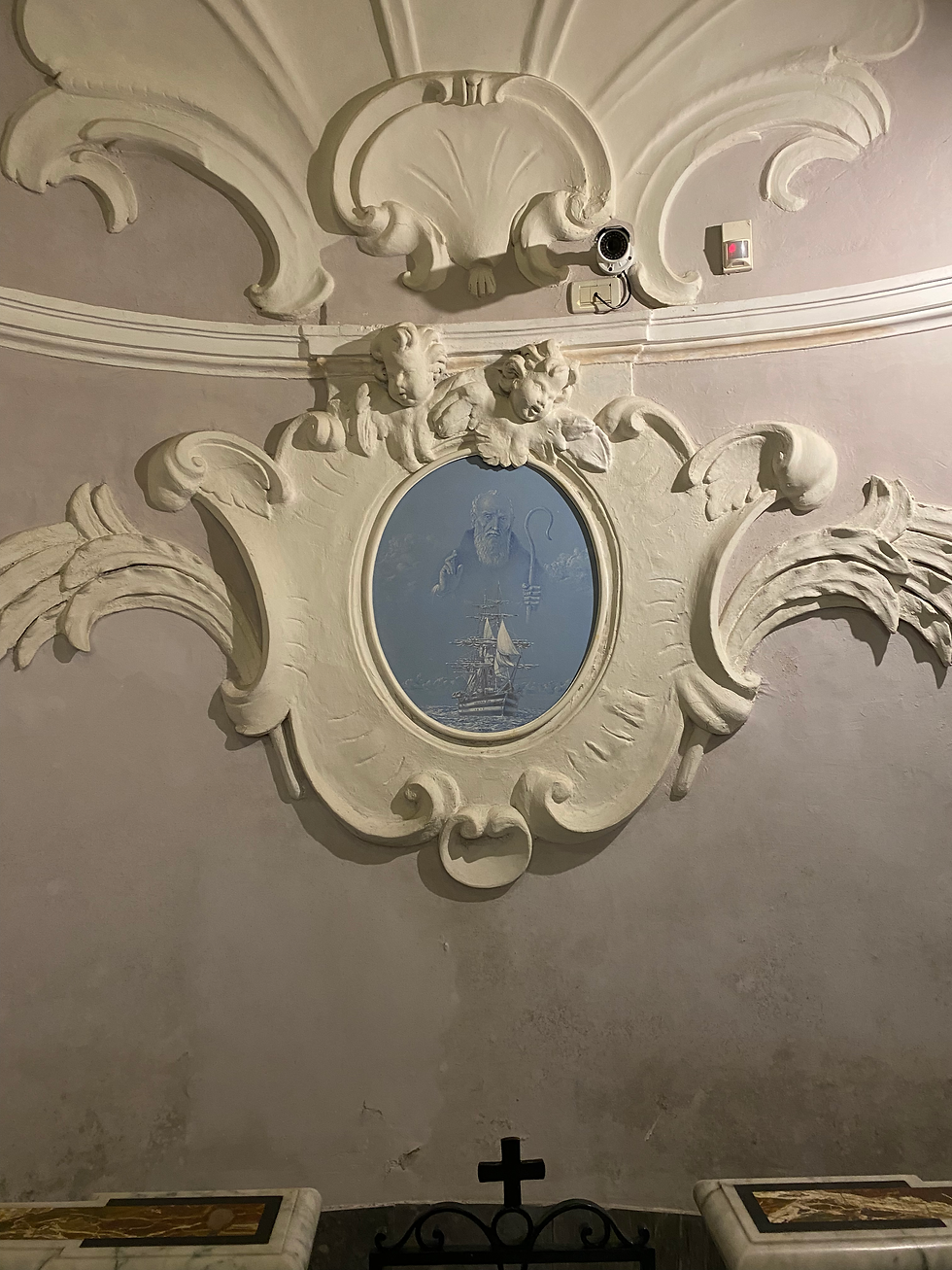Basking in the Basilica di Sant'Antonino
- ogl700
- Jul 18, 2022
- 4 min read
Updated: Jul 27, 2022
Your expansive guide to the ins and outs of the Sorrento church dedicated to St. Antonino
By Adriana Beltrano and Julia Doyle

This first picture depicts the exterior of the Basilica of Saint Antonino, located in Piazza Sant'Antonino in Sorrento. It is open to the public during the day, both for observation and for masses. When we visited the church around 5 or 6 PM, there was actually a mass that was starting right as we were leaving. We were treated to the echoing of psalms as we walked through the crypt under the altar. There was a good turnout of around fifty people, demonstrating that many visitors or people in the community continue to actively practice their Catholic religion at the basilica dedicated to the abbot of Sorrento.
The building itself dates from the 11th century, but it is rumored to have been built on top of a 7th century structure housing St. Antonino’s remains. The gray facade, however, is of the Renaissance style, and it was added along with the bell tower. The church was restored even more and made into a basilica in 1924 after it had been damaged by the invasion of the Turkish pirates in the 16th century.

Although the exterior looks a little underwhelming, the intricacies of the basilica hidden behind the front doors are mind-blowing. It was renovated during the Baroque period that took place between 1600 and 1750 and its influence is very prevalent. Typical of the Baroque style of architecture, the basilica contains rows of pillars, rigid form and symmetry, frescoes (paintings on the ceiling and wall), an ornate roof and entrance, and artwork with a sense of three-dimensionality. The interior marble columns, as seen below, are believed to have been taken and reused from abandoned Roman villas. As can also be seen below, every corner of the interior of the church is breathtakingly beautiful and detailed. Statues of Mary, Joseph, and Jesus as a child look down lovingly upon the congregation.


The frescoes typical of the baroque period such as the ones pictured above mostly depict the miracles that Saint Antonino performed during his lifetime. Some of the miracles include the victory over the Saracen invaders, the siege of General Grillo, salvation from the plague, recovery from cholera, and the freeing of possessed peoples. Saint Antonino performed many miracles over his lifetime, many of which are also depicted in the frescoes, these are just the ones for which he is most-renowned.

We now enter the crypt. It can be entered on either side of the altar by descending down the stairs, as it is located directly below. Because Sorrento is known for being a fishing town, many of the paintings depict Saint Antonino looking after the sailors and fishermen of the area. Pictured here is a nautical carving at the entrance to the crypt. Even after death he is believed to play a major role in guaranteeing safe travels, protecting the men from storms, and helping to ensure good catch. Many fishermen today still feel empowered by Saint Antonino.

One of the primary colors used in the crypt is white, giving it an angelic sentiment and making the viewer feel as though the presence of Saint Antonino is there watching over them. To add to the effect, a statue of the Saint sits directly in the center of the crypt looking out at all those who enter. Not only does it feel as though his presence is there, some of his remains are actually stored within the crypt. Before his death, Saint Antonino said he did not desire to be buried inside or outside of the city, so he was buried in the walls but his bones lie within the crypt. Below is an ancient crucifix and fresco of the Madonna that can be found in the crypt.
At his request, other part of his remains were cremated and the ashes were interned into the city wall to offer spiritual protection. St. Antonino is a protector of the city in many ways. St. Antonino’s most iconic accomplishment is saving a child from a whale. The child’s mother begged the saint to save her child, and St. Antonino was able to pull him from the stomach of the whale unharmed. An alleged rib bone of the whale is on display in the basilica’s lobby. Below are paintings and pictures of all the ships St. Antonino has saved, as well as ex voti dedicated to the saint. These are little silver depictions of body parts which are offered in thanks to St. Antonino for healing the offerers' ailments.

English translation of the base of the Sant'Antonino statue in the crypt:
Vigilant Sentry in the Defense of Sorrento, Pray for Us
Prayer
To be done in the act in which the devotee uses the blessed oil of S. Antonino
O glorious S. Antonino, in your mortal life you wanted to anoint a certain Bishop Sorrentino who fell from a mule with the blessed oil of Mary Immaculate and you cured him immediately. Animated by so much faith, I come to your feet, and to be healed of every infirmity of soul and body, I sign myself with your blessed oil in the name of the Father, of the Son of the Holy Spirit. Amen.
Three Glory

References:





















Comments